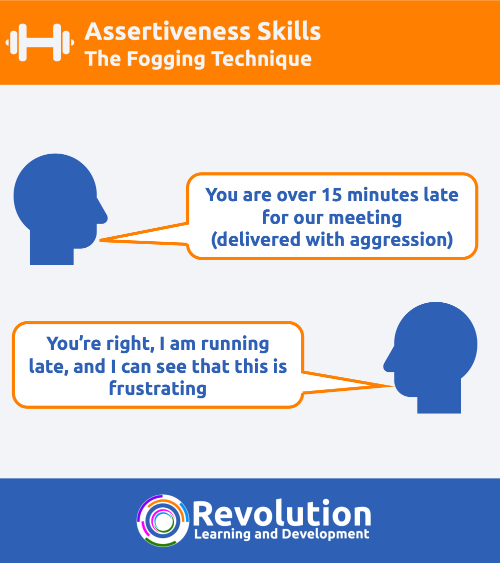Background
The fogging technique is an approach often used in assertiveness skills that helps us to provide a calm response to someone who is being aggressive towards us. When used correctly, the fogging technique aims to reduce further confrontation by not feeding the aggression, but rather quashing it. The technique was described by Manuel J. Smith in his book When I Say No, I Feel Guilty.
The technique allows for calmer and more controlled conversations and puts us in a position of being assertive.
The Fogging Technique
The fogging technique involves us showing that we agree with any truth that lies within what the other person is saying to us. When someone is aggressive towards us, the other person is more than likely expecting us to be aggressive or passive back. This then gives them the fuel (or reason) to continue to be aggressive.
By using the fogging technique, we take away this fuel by delivering a different response to what was expected. With no fuel, the other person begins to change their approach towards us and likely becomes calmer and more assertive themselves.
How to Use the Fogging Technique
To use the fogging technique, we should listen to what the other person is saying to us, regardless of how it is being delivered. Then, where something they state is true, rather than becoming defensive or argumentative, we simply state in a calm and clear tone that what they are saying is true.

Colleague: “You are over 15 minutes late for our meeting this morning. Where have you been?” (delivered with aggression)
You: “You’re right, I am 15 minutes later than planned and I can see this is frustrating” (delivered calmly)
Colleague: “Frustrated? Yes, I’m very frustrated. I could have been working on something else” (delivered with aggression)
You: “I recognise that you could have been working on something else during the time I wasn’t here” (delivered calmly)
Colleague: “In future, let me know that you are going to be late” (delivered with a more calm tone)
You: “Yes, I should have tried to let you know that I was running late” (delivered calmly)
Colleague: “Why were you late, is everything OK?” (delivered calmly)
We might assume that from the example conversation above that our responses may frustrate the other person, providing that our responses are always calm, we should find that they become calm too.
If we justify our position or become defensive or argumentative, then this conversation will quickly turn into an argument and will take much longer to resolve. What we want in the above situation is to get on with the meeting.
Applying the Fogging Technique
When using the fogging technique, you should consider the following things:
- Our response should always be calm and controlled, regardless of how we are feeling
- Our responses should not justify why it is true, but only state that it is true
- Our responses, where we can, should point out our perception of the other person’s feelings
- We should not apologise for the fact that it is true
Other Assertiveness Techniques
You could try to use the fogging technique alongside other assertiveness techniques such as the broken record technique. Trying to use too many though can become confusing for the other person and is likely to make the situation worse.
Further Learning
To learn more about the fogging technique and other assertiveness tools, take a look at our Assertiveness Training Course for more details.




